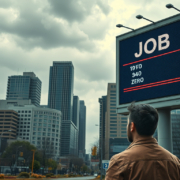From the Great Resignation to the Great Stay: Understanding the Shifts in Today’s Labor Market
From the ‘Big Stay’ to a ‘No-Hire, No-Fire’ Freeze: How Labor Markets Are Shifting in 2025
The labor world in the United States and the United Kingdom is changing fast. Covid-19 left a mark with many workers leaving their jobs. After what many called the “Great Resignation”, 2025 now shows a new trend. Workers hold on to their jobs, and firms slow new hiring and cuts. This change brings what some call the “Great Stay” and a freeze on both adding and letting go of staff.
The Pandemic-Era Shakeup: Great Resignation Recap
At the height of Covid-19, workers moved frequently. The U.S. Bureau of Labor Statistics showed nearly 50.5 million Americans quit in 2022, up from 47.8 million in 2021. People left to seek better pay, work from home options, and more satisfying roles.
Enter the Great Stay: Workers Holding Firm
In 2025, the scene flips. Nela Richardson, Chief Economist at ADP, names this stage the “Great Stay.” She points out that workers have the jobs they want. They keep the benefits from remote work and better pay while staying in a role longer than usual.
“People are staying put. They’re not leaving. And they’re staying put in sectors like IT and software development, where you’d usually expect a lot of movement,” Richardson said in a CNBC interview.
Workers now keep close to their roles, a clear break from the past chaos.
Employers’ Cautious Approach: No-Hire, No-Fire Market
Firms now act with care in a time of uncertain money. They stop new hiring and avoid layoffs. Richardson describes the scene as a “no-hire, no-fire” situation:
- Hiring decisions put on hold: Companies unsure of the economic path wait before adding more staff.
- Low layoff rates: Even with few hires, early claims for jobless benefits stay low. This shows that firms hold on to their staff.
This pause is a watchful step. Firms do not plan to cut numbers; they wait to see what comes next.
Signs of Cooling in Labor Markets
Recent numbers tell a clear story. In the U.S., nonfarm payrolls grew only 73,000 in July 2025. This number falls short of many predictions. The unemployment rate rose to 4.2%. These numbers may shape the Federal Reserve’s talk of interest rate cuts in their September meeting.
Parallel Trends in the United Kingdom
Workers in the UK face a similar scene. After record-high job openings in 2021 and early 2022 with nearly 1.3 million vacancies, the scene changed in mid-2025. The Office for National Statistics showed a 5.8% drop in job vacancies between May and July 2025 in 16 of 18 sectors.
The ONS also noted that:
- Many companies are not recruiting or replacing staff who leave.
- People aged 16-64 see a rise in doing neither work nor job hunting, with inactivity near 21%.
Monica George Michail from the National Institute of Economic and Social Research sees higher labor costs and tax and wage rises as part of the reason. Neil Carberry, CEO of the Recruitment and Employment Confederation, sees the same trend as a “Big Stay” like in the U.S. He notes that job growth depends on economic strength and a firm business mood. With both low now, companies wait for clearer signs before moving ahead.
What Does This Mean for Workers and Employers?
- For workers: The Great Stay means more job security. This low movement may strengthen how workers speak up for better terms, but it can also make it hard to change roles.
- For employers: Holding off on hiring shows care in tough times. Yet, this pause might slow growth and new ideas when firms need fresh talent.
Conclusion
The shift from the past churn of the Great Resignation to today’s Great Stay and the no-change hiring mode shows how doubt about money shapes work trends. Workers stick with their roles, and firms keep a close eye on any changes. This quiet mode may continue as 2025 unfolds. Leaders in government and commerce must soon watch these trends to keep balance while seeking a fresh burst of growth.
For more news on work trends and money policy, keep watching CNBC’s full coverage.
Full money-growing playbook here:
youtube.com/@the_money_grower









